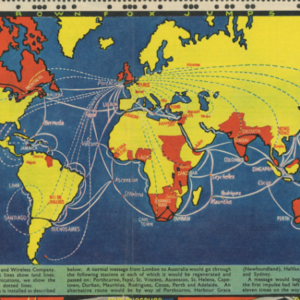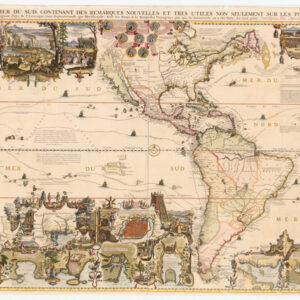Japanese Board Game Geography.
Round the World Sugoroku [家庭教育世界一周すごろく].
$575
In stock
Description
This is a 1926 (Taisho 15) Japanese pictorial world map and round-the-world sugoroku game published as a supplement to the New Year’s Edition of the Osaka Mainichi Shimbun (大阪毎日新聞) (it is traditional to play sugoroku on New Year’s Day). Similar to snakes and ladders, the game involves players racing from a starting point to a common endpoint. In this case, the players must start from Japan and travel to London before returning to Japan. They either begin in Tokyo and travel across Eurasia or begin in Osaka and travel through the Americas and across the Atlantic before taking the alternate route back, thus completing the trip around the world.
The cartoonish figures on the map reference cultural stereotypes and recent historical events, such as the assassination of Franz Ferdinand, the Rif War in Morocco, and the renaming of St. Petersburg to Petrograd and then Leningrad. The figure holding a Japanese flag in the Canadian Rockies is Maki Yūkō (槇有恒), the most accomplished Japanese mountain climber of the time.
Sugoroku of this era often had an educational or didactic purpose and were geared towards inculcating patriotism and good morals in children. The early 20th century saw the development of mass youth culture, including comics, magazines, and literature in Japan (dubbed Shōnen for boys and Shōjo for girls), and sugoroku games like the present example fit within this wider cultural current.
Cartographer(s):
The Osaka Mainichi Shimbun was founded in 1876 and quickly became one of the major newspapers in Japan. In 1911, it merged with the Tokyo Nichi Nichi Shimbun though the two papers continued to operate independently until 1943, when they were fully combined as the Mainichi Shimbun, still one of the major daily newspapers in Japan.
Condition Description
Wear along fold lines.
References



![[Ortelius & Hogenberg Atlas Factice]](https://neatlinemaps.com/wp-content/uploads/2023/03/NL-01678-leo-belgicus-3_thumbnail-300x300.jpg)